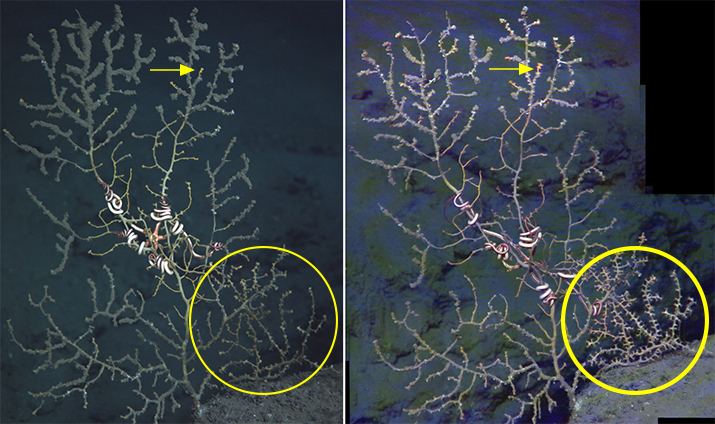Scientists from Woods Hole Oceanographic Institution (WHOI) helped find strong evidence that the Deepwater Horizon oil spill in 2010 had impacts on deep-sea coral communities in the Gulf of Mexico. The study, published March 2012 in Proceedings of the National Academy of Sciences, used all of the deep-sea robotic vehicles of the WHOI-operated National Deep Submergence Facility—the three-person submersible Alvin, the remotely operated vehicle Jason, and the autonomous underwater vehicle Sentry—to investigate corals near the ruptured Macondo well. “These corals exhibited varying levels of stress, including bare skeletons, tissue loss, and excess mucus production—all associated with a covering of brown flocculent material,” said WHOI biologist Tim Shank. The study’s lead author, Helen White, a geochemist at Haverford College, worked with WHOI marine chemist Christopher Reddy and WHOI research specialist Robert Nelson to identify oil found in the coral communities. They documented evidence that its source was the Macondo well, using an advanced technique called comprehensive two-dimensional gas chromatography, which was pioneered at WHOI by Reddy and Nelson. Pen-Yuan Hsing, a graduate student at Penn State University (PSU), documented further evidence by analyzing 69 images of 43 individual corals taken with cameras on undersea vehicles. The study grew out of a research cruise to the Gulf led by PSU biologist Chuck Fisher in late October 2010, six months after the Deepwater Horizon oil spill. This expedition was part of an ongoing study of deep-sea life in the Gulf funded by the Bureau of Ocean Energy Management and the National Oceanic and Atmospheric Administration. Using Jason, the team discovered numerous distressed and flocculate-covered coral communities 6.8 miles from the Macondo well. Despite the corals' proximity to the well, when they were first observed, the visible damage could not be directly linked to the Deepwater Horizon spill. The research team, again headed by Fisher and augmented by White, returned a month later, funded by the National Science Foundation’s RAPID Collaborative Research grant program. “It is easy to see the impact of oil on surface waters, coastlines, and marine life, but this was the first time we were diving to the seafloor to examine the effects on deep-sea ecosystems,” White said. On its return trip, the team employed Sentry to map and photograph the ocean floor and Alvin to get a better look at the distressed corals. “We don’t know the long-term impacts on these corals,” Shank said. “Beyond that, the corals serve as hosts to other animals—crabs, shrimp, and brittle stars—that may be affected by the loss of their habitat. We hope our continued monitoring of this site will give us insight into whether they will recover.” Erik Cordes (Temple University), Chris German and Rich Camilli (WHOI), Walter Cho (now with Gordon College), and other scientists from Penn State, Temple, and the U.S. Geological Survey contributed to this research. Originally published: September 6, 2012 Last updated: August 12, 2013 | |||||||||||||||||||||||
Copyright ©2007 Woods Hole Oceanographic Institution, All Rights Reserved, Privacy Policy. | |||||||||||||||||||||||


